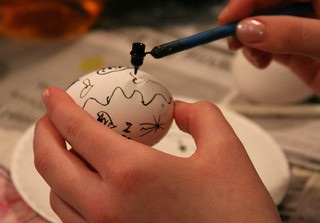It starts with a blank, raw egg in the palm of my hand. White, cold, and smooth, except for some sand-like bumps. I take the kiska—a thin, wooden rod with a cone-shaped piece of metal secured with wire at one end. With this cone, I scoop a chunk of beeswax and stuff it in deep with my thumbnail. The beeswax feels good, smells good. Like pollen, flowers, and the trees surrounding my childhood home in suburban New Jersey, right outside New York City.
I hold the tip up to a candle and watch as the flame licks and wraps its orange tongue around the metal. As the mustard-colored wax melts just enough to leak through the narrow end of the cone, I place the tip on the shell and draw a vertical line, splitting the egg in half. The drip hardens as it hits the surface. I draw two more lines, on diagonals, forming an X, or maybe more of a star, depending on how you hold it.
My siblings and I often made these traditional, decorated Ukrainian Easter eggs, called pysanky, to placein our family’s Easter basket along with chocolate, babka, kobasa, cheese, horseradish, butter, salt, holy water, and ham. On the Saturday before Easter, we would bring the basket to church to be blessed by the priest, so we have holy food to eat after Sunday’s three-hour, standing-room-only mass.
My grandmother—my mother’s mother—also used to make pysanky every year. But she kept it old school, using a bobby pin to draw the intricate lines, shapes, and figures with the wax. Then, she would dip her designed eggs in a special dye made from boiled onion peels, just like in her Ukrainian village, where the dyes were made from the earth—berries, roots, leaves. Today the eggs are dyed a multitude of intense colors in a specific order, from light to dark. They are sharp-smelling mixtures of vinegar and bright, concentrated powdered pigments that come in little paper packages sold in New York City’s East Village.
My grandmother’s eggs were only two colors, my mother says, brown and cream. But they were some of the most beautiful ones she’d ever seen.
* * *
With a large spoon, I swirl the wax-covered, bobbing egg in a cup of yellow liquid that looks like a urine sample. I scoop it out after a few minutes; the dye stains my fingertips. The egg is greatly golden, except for the raised caramel lines of wax. They keep the dye from staining that part of the shell.
The yellow symbolizes youth, wisdom, harvests. In Ukrainian culture, everything means something—colors, shapes, feelings, words, actions—everything.
Superstitions and dream interpretation were particularly my grandmother’s shtick. But she didn’t pass them on to me—I learned them from my mother. I try to brush them off, the superstitions, the dream symbolizing. I tell myself it’s not true wisdom, some essential insight from deep within the Carpathians. Most of the strongest superstitions center around pregnancy and marriage. You know—don’t prep the nursery before the baby comes, don’t stare at an ugly person while pregnant because your baby will look like him, it’s not good to wear pearls with your wedding dress. But there are some things that refuse to leave the tightened pit of my stomach: how it’s bad luck every time I turn back to get something I’ve forgotten at home; how it means someone will die soon if my cat rolls on her back and looks me in the eyes; how it means trouble lies ahead, when my grandmother who died three years ago is sitting silently in my dream, a cold specter that vanishes the moment my gray hand reaches out…
* * *
The wax oozes like molasses out of the kiska’s tip. I continue to draw crooked lines, incoherent squiggles and shapes. My wrist aches as I try to draw a sunflower, Ukraine’s national flower, one of my grandmother’s and my mother’s favorite flowers.
I draw a line that has no place. I shriek. “Relax,” my mother coos in Ukrainian. It doesn’t have to be perfect. I want to throw it, to see the liquid yolk stain the kitchen’s ivory walls. I sigh and get up to toss the egg into a pool of rusty orange, the color of endurance and strength.
My grandmother grew up on a small farm in the mountains most of her life, working as a schoolteacher in the village. Then the war hit, and she trekked to Germany to find her father, who went there to find work, with nothing but his name and a vague descriptor of his location.
At this time, she was married to another man, a man who would not be my mother and uncle’s father, a man that would not be my grandfather. A man that would eventually leave my grandmother to live on a farm with another woman in Poland.
Yet my grandmother moved on, soon meeting my grandfather in a German war camp. The two fell in love, as these stories go, and vowed to reunite in America.
What my grandmother didn’t realize was that her father, once she found him, secured their bid to America by promising her hand in marriage to another man, a man she did not know. But she stood her ground, refused to marry this way.
Yet this man—whose identity is now lost among my family’s trove of legends—still agreed to bring my grandmother and her father to America, to Philadelphia, where her skeletal apartment had nothing but a mattress to sleep on and the ghostly moonlight to read under.
My mother says my grandparents never wanted to go back to Eastern Europe, a place where my grandmother’s divorce was solidified after advertisements in Polish newspapers looking for her first husband went unanswered.
My grandparents loved America to the bone. It’s because they did it; they made it. They passed through Ellis Island, found each other serendipitously, and saved each cent for a charming row home, where they spent their days watching soap operas and nights listening to the news.
* * *
Blue represents the sky, air, good health. Truth and fidelity. It’s the next color in the dyeing line.
Ukraine’s flag is two, simple horizontal stripes of blue and yellow, for the clear skies and the lush, fertile wheat fields. And in my grandmother’s village, the women wore a lot of blue among their peasant blouses and pleated skirts. But this is pretty rare. Most of Ukraine’s costumes and daily garb included little blue and a lot of red, lots and lots of red—red boots, red beads, red headdresses, red embroidery. Red for love, action, life. Passion and anger. Christ and blood. Hope and spirituality.
A New York City pysanky artist (whose eggs sell for 80 bucks a pop, I kid you not) said it is also rare to see an egg dyed a deep shade of lapis. It has something to do with the pigment’s rarity and exquisite brilliance.
I cup the egg in my palm. I don’t have any blue.
* * *
The bright red dye makes my pysanka with its squiggles of hardened wax look deformed, like the legs of a boiled lobster. I hold the egg up so it is at the same level as my green eyes. The deep scarlet isn’t taking uniformly; dark lines run down along the shell’s minute imperfections.
I sigh. This is why I never pursued art, I think.
My mother says I have a gift for crafts and the ability to make anything I want; I have steady hands. She usually says this after I clip on one of her diamond bracelets for a wedding, or when I untangle one of my sister’s necklaces. She says I have her mother’s hands, which she had always hoped to have. Hers shake too much, she claims.
When my grandmother came to America, she snagged a job rolling cigars in a factory because of her hands. And she was especially adept in the arts—drawing, beading, crocheting, crafting. She quit smoking by knitting a huge blanket, using size 40 needles and doubling the thickest yarn she could find. She made it decades ago, but my mother, sister and I still rotate sleeping with it on the couch every morning.
* * *
I’m running low on wax and patience, but I’ve reached the final color.
Black is associated with death, loss, grief. Though I don’t remember much of my grandmother, I remember when my grandmother died. I was a freshman in college. I cancelled a flight to visit a friend in Chicago. My family and I packed up our things, went to Philadelphia. Stayed in a plush hotel. Met up with our rarely seen cousins from Florida. Had the wake. Said our final goodbyes the next morning—to the clay-like body before me, the suit dress covering thick ankles—and had the funeral. Went to the bathroom in the church basement before the burial.
That day my mother, who spent years traveling to Philadelphia and back to check on her parents, could only remember my grandmother yanking her out of mass as a child for talking. “You’re embarrassing me,” she used to say to her.
It feels strange dyeing the eggs black. They are supposed to represent life, hope, eternity—not death and finality.
I take the egg, now completely covered, and hold it up to the flame. The heat begins to melt the wax away, and it trickles down the shell.
I felt strange at my grandmother’s funeral; I didn’t know how to feel. I hardly recognized her figure, except for our identical, bumpy noses, and barely said anything to my grandfather, who kept his toothless mouth shut the entire weekend, squeezing his navy blue cap in his hands.
Growing up, I rarely saw my Philly grandparents. They were a distant mirage I heard scant stories about but did receive a birthday card from every year. My grandfather spent his final days taking care of my grandmother, who was nearly blind and unable to walk from diabetes. She had long lost the gift of dexterity. But my mother still sent her blown-up photos of us kids, and sometimes my writing. She would read and translate my childhood poetry and stories to my grandmother over the phone. I caught my mother smiling one time, the phone tucked in the crook of her neck, her slippered foot bouncing. My grandmother had just said I should never stop writing; she was sure I had her genes, my mother said.
If only I could have heard that myself.
With a paper towel I wipe away the melted wax. The shell looks like stained glass, a rainbow of primitive patterns, energetic colors, stark lines, and on one face, a prismatic sunflower with jewel-colored leaves.





Beautiful. Post more stories I wanna read them!